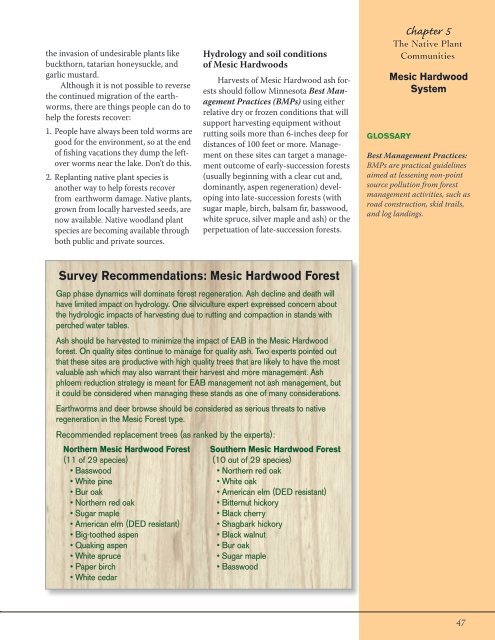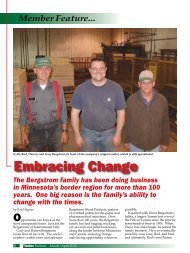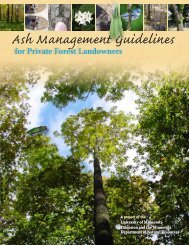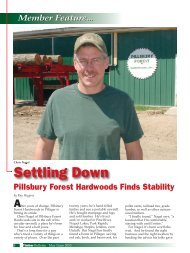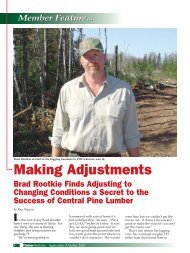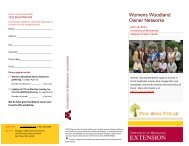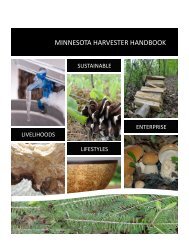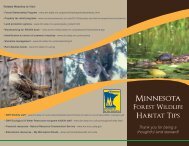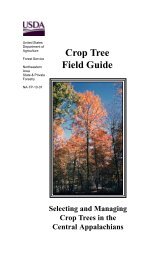Ash Management Guide for Private Forest Landowners
Ash Management Guide for Private Forest Landowners
Ash Management Guide for Private Forest Landowners
You also want an ePaper? Increase the reach of your titles
YUMPU automatically turns print PDFs into web optimized ePapers that Google loves.
the invasion of undesirable plants likebuckthorn, tatarian honeysuckle, andgarlic mustard.Although it is not possible to reversethe continued migration of the earthworms,there are things people can do tohelp the <strong>for</strong>ests recover:1. People have always been told worms aregood <strong>for</strong> the environment, so at the endof fishing vacations they dump the leftoverworms near the lake. Don’t do this.2. Replanting native plant species isanother way to help <strong>for</strong>ests recoverfrom earthworm damage. Native plants,grown from locally harvested seeds, arenow available. Native woodland plantspecies are becoming available throughboth public and private sources.Hydrology and soil conditionsof Mesic HardwoodsHarvests of Mesic Hardwood ash <strong>for</strong>estsshould follow Minnesota Best <strong>Management</strong>Practices (BMPs) using eitherrelative dry or frozen conditions that willsupport harvesting equipment withoutrutting soils more than 6-inches deep <strong>for</strong>distances of 100 feet or more. <strong>Management</strong>on these sites can target a managementoutcome of early-succession <strong>for</strong>ests(usually beginning with a clear cut and,dominantly, aspen regeneration) developinginto late-succession <strong>for</strong>ests (withsugar maple, birch, balsam fir, basswood,white spruce, silver maple and ash) or theperpetuation of late-succession <strong>for</strong>ests.GLOSSARYChapter 5The Native PlantCommunitiesMesic HardwoodSystemBest <strong>Management</strong> Practices:BMPs are practical guidelinesaimed at lessening non-pointsource pollution from <strong>for</strong>estmanagement activities, such asroad construction, skid trails,and log landings.Survey Recommendations: Mesic Hardwood <strong>Forest</strong>Gap phase dynamics will dominate <strong>for</strong>est regeneration. <strong>Ash</strong> decline and death willhave limited impact on hydrology. One silviculture expert expressed concern aboutthe hydrologic impacts of harvesting due to rutting and compaction in stands withperched water tables.<strong>Ash</strong> should be harvested to minimize the impact of EAB in the Mesic Hardwood<strong>for</strong>est. On quality sites continue to manage <strong>for</strong> quality ash. Two experts pointed outthat these sites are productive with high quality trees that are likely to have the mostvaluable ash which may also warrant their harvest and more management. <strong>Ash</strong>phloem reduction strategy is meant <strong>for</strong> EAB management not ash management, butit could be considered when managing these stands as one of many considerations.Earthworms and deer browse should be considered as serious threats to nativeregeneration in the Mesic <strong>Forest</strong> type.Recommended replacement trees (as ranked by the experts):Northern Mesic Hardwood <strong>Forest</strong>(11 of 29 species)• Basswood• White pine• Bur oak• Northern red oak• Sugar maple• American elm (DED resistant)• Big-toothed aspen• Quaking aspen• White spruce• Paper birch• White cedarSouthern Mesic Hardwood <strong>Forest</strong>(10 out of 29 species)• Northern red oak• White oak• American elm (DED resistant)• Bitternut hickory• Black cherry• Shagbark hickory• Black walnut• Bur oak• Sugar maple• Basswood47


